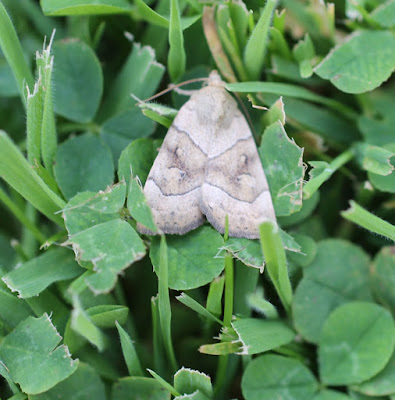 |
| After the moth release. |
An early morning inspection of the trap was encouraging and there were a number of colourful species that might interest Year 6 primary school children. Persuading the moths into the collecting tubes and then attaching a label with the common name written on it seemed the best way to give the children some basic information. It was the names that attracted me in the first place after all - so the plan was to include 'moths to expand vocabulary'.
Moths tend to settle in the darkest part of the tube - next to the white screw-top cap - and that is where they are most difficult to observe - so a back-up of projected images showing each species more clearly was useful.
 |
| Dun-bar (Cosmia trapezina) |
This Dun-bar (Cosmia trapezina) did not represent itself in its usual colours of brown or ochre and this monochrome version was puzzling at first. A common moth at Shandy Hall with a scientific name that introduces geometry, referring to the quadrilateral with two sides parallel - the trapezium.
 |
| Clay (Mythimna ferrago) |
The Clay (Mythimna ferrago) seems to be on the increase. Generally numbers for all species have been discouraging this year but The Clay seems to be doing well. Feeding on dandelion and chickweed, or grasses generally, it is quite easy to identify with the two white dots showing quite clearly.
 |
| Bright-line Brown-eye (Lacanobia oleracea) |
The Bright-line Brown-eye (Lacanobia oleracea) displays both line and eye - the bright line at the base of the wings, looking like very sharp teeth and the brown/orangey 'eye' make it distinctive. Both parts of the scientific name refer to vegetables, living as the larva does on the roots of greens.
 |
| Slender Brindle (Apamea scolopacina) |
The Slender Brindle (Apamea scolopacina) is not common in the garden and only shows its beauty with close inspection. Click on the image to enlarge the photoraph and the complex patterns that can be seen on the wings are remarkable. The second part of the binomial (the specific epithet) refers to 'scolopax' - the woodcock; the bird with 360 degree vision.
 |
| (Aethes cnicana) |
This was an unknown moth when it was taken to Husthwaite Primary School. Two of the girls tried to match the moth to the appropriate Lewington drawing in the Micro-moths Field Guide but they found it very difficult as the moth would not stay still. As it is important to help the children to understand that no harm should befall these hapless insects and they should be disturbed as little as possible, it was put in a cool place and left to settle down. When I returned home I photographed it as well as I could and I am pretty sure that Aethes cnicana is the correct identification. There has only been one recorded in the gardens in the last ten years and that was more strongly marked. The photograph is not ideal as the moth is illustrated from the side, but the patterns seem consistent for it to be a Thistle Conch (Aethes cnicana).
